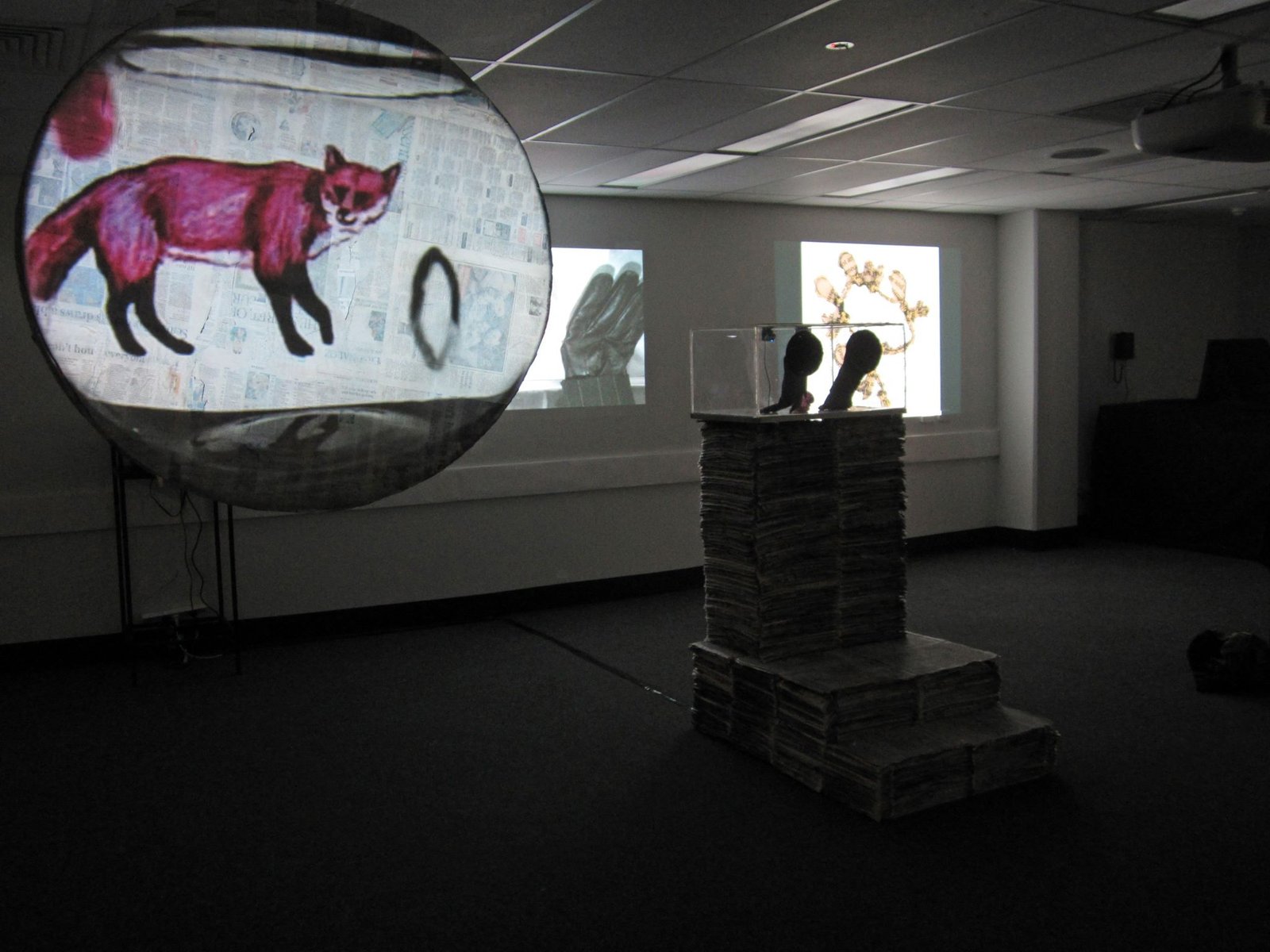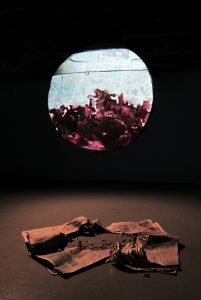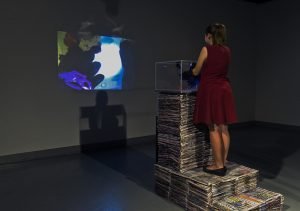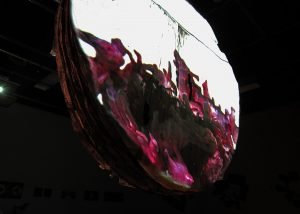Full text pdf: newsfactory_artiststatement_laurenedmonds_2014
News Factory
Artist Statement by Lauren Edmonds
This body of work investigates the deliberate distortion of information in the news media in order to manipulate the masses. In this investigation I have experimented in a variety of media and methods to create work that effectively engages the viewer in a way that attempts to spur on thought or a greater awareness of the issues being addressed.
My work studies the ‘commercial logic’ that has made way for misinformation to plague the news media on an immense scale. Some works delve into the original psychological theories behind public relations to expose the unspoken ironies, hypocrisies and injustices as PR content now circulates uncontrollably throughout the news media. Others investigate the relationship and separation between the masses and the manipulator and the roles they play. Throughout a number of works there are aesthetic references to science, addressing the relationship between science and propaganda.
News Factory (2014) Installation view, 2 projections onto suspended object
The application of ‘commercial logic’ by media moguls has resulted in journalists becoming ‘Churnalists’, finding themselves repackaging stories from wire agencies, competing publications, PR agencies or resorting to illegal activity to keep up with their work demands. Commercial logic warns churnalists against producing stories that challenge the status quo, afraid of losing consumers or angering someone powerful. A ‘fish bowl effect’ is occurring where a conservative outlook that supports the status-quo is being circulated by the news media. The PR industry contributes to this effect as it can only be afforded by the powerfully wealthy (Davies 2009). Edward Bernays who coined public relations in the 1920s theorised that without an invisible ruling power that ‘manipulated the organised habits and opinions of the masses’, democracy would fail and irrational thought and animalistic forces would consume society into chaos (Bernays 2005). Ironically, PR now seems to amplify these irrational feelings globally through the world media.
Understandably this investigation into the manipulation of the masses in the news media has led to research into the roles of both the manipulator and the masses. Looking at figures of power and influence in the news industry, it is hard to look past media mogul, Rupert Murdoch. Murdoch not only influences the content of his own outlets but he has influenced the global news climate by monopoly. He exploits his power to manipulate the masses and politicians in his own corporate interests.
Faux (2014) 76 x 58cm pastel, conte, charcoal, ink on paper
“I got to like him more and fear him less now that…there’s nothing he can do to put me in power or not put me in power…” Tony Blair (Sutherland .J, Murdoch, 2013)
Murdoch is generally feared by many people in the news media industry, particularly those that work under News Corp. He is even feared by political leaders, interfering with government elections and political parties for decades, particularly in Australia and the UK. In my drawing “Faux”, I have positioned the viewer in my drawing to feel as though they are looking up at Murdoch, emphasising his power and dominance. I have also incorporated the imagery of a fox which refers to his ownership of the notorious Fox News as well as comparing characteristics of a fox to Murdoch such as being; sly, cunning and potentially threatening. As genuine fur skins are expensive, the fox is also a symbol of wealth and even greed. I have also used the imagery of the fox in other work to create a comparison between these seemingly ‘animalistic’ traits of powerful figures such as Murdoch and the theorised ‘animalistic’ traits of the masses that Bernays justified public relations over. Through this comparison perhaps I can expose some hypocrisies or open up some questions on the relationships between the manipulator and the manipulated.
I became interested in hands as a way of expression of power early on in this project due to recognising that photographs of Murdoch online often included his hands in certain gestures. A short investigation into these hand gestures found that one of the most commonly depicted hand gesture seen in the various photos of Murdoch is known as the ‘steeple’ and is one of the strongest hand gestures of power and dominance. This revelation has influenced my work thereafter, with the reference to hands being a strong link between many, if not all my work. Whether it be the emphasis of hands in my drawings, the gloves in my interactive work, the filmed hands in my projection work or the hand wound automatons.
The colour pink and the plasticine figures have been reoccurring imagery across a number of works. This imagery largely originated from reading the work of French philosopher, Jacques Ellul in his book “Propaganda: the Formation of Men’s Attitudes” (1973). A point Ellul discusses that I found interesting was how when individuals are a part of a mass their psychic defences are weakened and they are more easily able to be manipulated to act in a certain way. They become more receptive, in a state of psychological regression, although they often pretend all the more to be ‘strong individuals’. Another idea Ellul explores is that people who routinely read a favourite newspaper or regularly listen to a certain radio station (or other medias) can be found to exhibit a mass mentality and that they form a sort of organic mass that have the same motives, myths, receive the same impulses and impressions, same centres of interest and experience the same order of reactions and ideas. These ideas led me to form a visual representation of the masses that was mouldable, vulnerable and all as one in the same.
Quarantine Manipulator (2014) interactive installation
“Quarantine Manipulator” is an interactive installation exploring various ideas concerning the relationship between the masses and the manipulator and scientific knowledge, power and propaganda.
The work plays on the aesthetics of a scientific ‘quarantine isolator,’ used by scientists to test and experiment with substances that might be harmful to handle in an otherwise, uncontained situation. My use of this aesthetic has layered meanings and connotations. Firstly, the aesthetic of the quarantine isolator refers to modern propaganda’s dependence on scientific analyses of psychology and sociology (Ellul 1973, 4). The nature of propaganda can also take a scientific experimental approach in order to advance its strategies and tactics. The isolator aesthetic also emphasises the separation between the manipulator and the manipulated; how the manipulator sees themselves as being ‘above’ the masses they manipulate and issues of class warfare that this idea arises. This is achieved through the fact the gloves and perspex case physically prevent the participant from directly coming in contact with the pink plasticine which represents the masses and the steps leading up to the isolator forcing the participant to ‘move up in the world’. There is also the idea of the hidden mastermind/manipulator who leaves no traces of their mark.
The installation is interactive and allows viewers to step up to the isolator and put their arms through the suit sleeves and gloves to manipulate the pink plasticine inside. The participant is unable to look down and see through the isolator to see what their hands are doing, instead if they look down they are confronted with their own reflection in a mirror. However they are able to see what their hands are doing by looking out at a projection in front of them on a wall of a live video feed from a webcam within the isolator. This interactive experience almost becomes a sort of ‘simulation’ of being a powerful figure or manipulator. In doing so, the work becomes a sort of parody while emphasising the separation between the participant (as part of the mass) and the powerful. When a participant looks down they see their own reflection in the mirror, symbolising how the manipulator has only their own interests in sights. By directing the participant to look upon the projection of their hands in order to see what they are doing, I am drawing the viewer’s attention to the manipulator’s out of touch perspective of the masses. The steps have been covered in cut and layered newspaper to appear as if they have been constructed of stacks of newspaper. I have chosen to do this to refer the foundations or tools of power over the masses: mass and news media or the manipulation of information that is fed to the masses.
References
Bernays, Edward L. 2005. Propaganda. Brooklyn, N.Y: Ig Publishing.
Davies, Nick. 2009. Flat Earth news: an award-winning reporter exposes falsehood, distortion and propaganda in the global media. London: Vintage.
Ellul, J. 1973. Propaganda: the Formation of Men’s Attitudes: Vintage Books.
Sutherland, J. (Director). (2013). Murdoch [Documentary]. Australia: Electric Pictures, UK: Brook Lapping Productions
Curtis, A. (Director). (2002). The Century of the Self [four part documentary]. UK: BBC Four


![Faux [2014]](https://www.laurenedmonds.com/wp-content/uploads/2014/11/Faux_Lauren_Edmonds_lowres-224x300.jpg)

